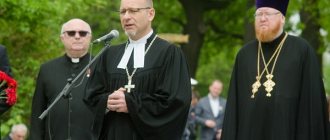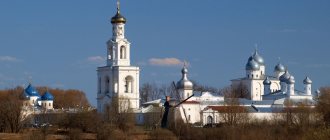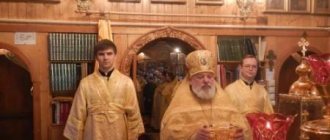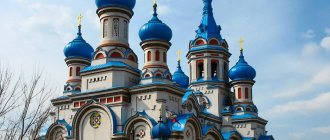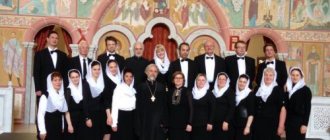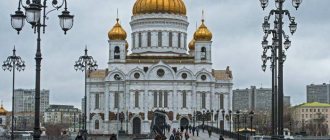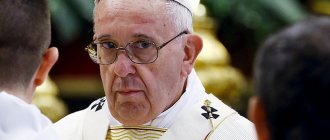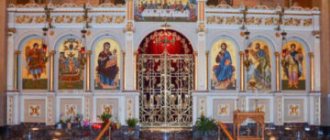Protestantism (or Protestantism) is a Lutheran, Calvinist and Anglican religion, these Christian churches split from Roman Catholicism in the 16th century. Since that time, Protestantism has become the name of the beliefs of Protestants. Martin Luther (1483–1546) was the founder of German Protestantism.
Protestant - a member of one of the Protestant churches.
Martin Luther (1483—1546)
Lutheran Reformation[edit | edit code]
The beginning of the Lutheran Reformation in Germany[edit | edit code]
It is believed that Lutheranism dates back to October 31, 1517, when the German Catholic monk Martin Luther published 95 theses against abuses of church power in Wittenberg, Saxony. Luther did not try to create a separate Christian denomination, he only wanted to cleanse Catholicism of the dogmatic errors that had accumulated over the centuries. Soon, in 1520, the Catholic Church declared him a heretic, and the emperor declared him a criminal (Edict of Worms 1521). However, the monk's protest unexpectedly found a response among the German princes. Luther's secular defender was the Saxon Elector Frederick III, who hid him in the Thuringian castle of Wartburg, where Luther was able to translate the Bible into German. Later, a number of Lutheran princes declared themselves at the Imperial Diet in Speer in 1529 and received the name Protestants. However, in the same year, as a result of the Marburg Dispute, contradictions were revealed within the Protestant camp between Lutherans and Calvinists. In 1530, Lutherans formulated the Augsburg Confession, which was rejected by Emperor Charles V at a meeting of the Reichstag. Then the Lutheran princes of Saxony and Hesse formed the Schmalkaldic League in 1531. The death of Martin Luther becomes a convenient reason for unleashing the Schmalkalden War, as a result of which the Lutherans are defeated. In 1548, the Augsburg Provisional Decree followed - a temporary truce with Catholics, which enshrined the main dogmas of the Catholic Church, making minor concessions to Protestants (non-obligatory celibacy for pastors and allowing communion under two types). The Augsburg Interim was followed by the Leipzig Interim, signed by Philipp Melanchthon. However, the activities of Duke Moritz made it possible to conclude the Peace of Augsburg (1555), which legalized Lutherans in the Holy Roman Empire.
Lutheran Reformation in Scandinavia and the Baltics[edit | edit code]
Meanwhile, in 1527, King Gustav Vasa begins the Lutheran reformation in Sweden, of which Finland (including Vyborg) was a part.
In 1536, King Christian III makes Lutheranism the state religion of Denmark, which at that time included Norway and Iceland.
In 1555, the Peace of Augsburg was concluded, which consolidated the division of Germany into the Lutheran North (Brandenburg, Hesse, Saxony) and the predominantly Catholic South (Bavaria).
In 1561, Lutheranism strengthened in the Baltic states when the last Landmaster of the Teutonic Order in Livonia, Gotthard Ketler, renounced Catholicism and founded the Duchy of Courland. That same year, Swedish Lutheranism took root in Estonia.
Polemics with Calvinists and the creation of the “Formula of Concord”[edit | edit code]
Melanchthon's conciliatory position (the signing of the Interim in 1548) caused a split among Lutherans between the Gnesiolutherans and the Philippists (named after Philip Melanchthon) on the issue of attitude towards the nature of the Sacrament. In 1560, for a short time, the Phillipists managed to defeat the Gnesiolutherans and spread their influence throughout Saxony. Wittenberg became the center of the Phillipists. However, in 1574 the Phillipist party was defeated. The dispute ends with the writing of the Book of Concord in 1580, which lays the foundation for confessional Lutheranism, and the period of short-lived peace is called “Lutheran orthodoxy,” but its dryness soon causes a reaction in the form of pietism.
Counter-Reformation[edit | edit code]
The Council of Trent of the Catholic Church, which ended in 1563, condemned Lutheranism and turned the Reformation into a schism.
Religious wars of the 17th century[edit | edit code]
The 17th century was marked by religious wars with Catholics, one of which led to a draw (the Thirty Years' War), and the second contributed to the consolidation of Lutheranism in Latvia (the Polish-Swedish War). In both wars, King Gustav II Adolf proved himself to be a heroic defender of Lutheranism.
Who are Protestants
In the sixteenth century in Western Europe there was a separation of a significant part of believers from the Roman Catholic Church. This event in historiography is called “reformation”. Thus, Protestants are a part of Christians who disagree with Catholic principles of worship and some issues of theology.
Next, we will look at the differences between Protestantism and such movements as Orthodoxy and Catholicism. In the meantime, it’s worth delving a little into the history of this movement.
The Middle Ages in Western Europe turned out to be a period when society became completely dependent not so much on secular rulers as on the church.
Almost no issue was resolved without the participation of a priest, be it a wedding or everyday problems.
Weaving more and more into social life, the Catholic holy fathers accumulated untold wealth. The flashy luxury and double standards practiced by the monks turned society away from them. Dissatisfaction grew due to the fact that many issues were prohibited or resolved with the forced intervention of priests.
It was in this situation that Martin Luther had the opportunity to be heard. This is a German theologian and priest. As a member of the Augustinian order, he constantly observed the corruption of the Catholic clergy. One day, he said, an insight came about the true path of a devout Christian.
The result was the Ninety-Five Theses, which Luther nailed to the church door in Wittenberg in 1517, and a campaign against the sale of indulgences.
The basis of Protestantism is the principle of “sola fide” (only through faith). It says that no one in the world can help a person to be saved except himself. Thus, the institution of priests, the sale of indulgences, and the desire for enrichment and power on the part of church ministers are rejected.
Let's take a closer look at the theological differences between the three areas of Christianity.
Pietism and faith movements[edit | edit code]
Teaching[edit | edit code]
Pietism defines Christianity as "the Christian life"; indifference to the teachings of Christ (dogmas), emphasis on a highly moral life, personal piety, encourages separatism in the community.
Doctrine of Justification:
Reanimation of Osiander's views. Confusion of the concepts “Justification” and “Sanctification, internal renewal.” The pure doctrine of imputation is replaced by a vague idea that justification and sanctification are a single whole, the so-called “new birth”, which no longer coincides with the concept of forgiveness of sins, but means an internal transformation that is the source of a new “Christian” behavior. Those. Synergism replaces monergism, both in justification and sanctification.
Doctrine of Salvation:
Platonic tendencies colored by synergy
Doctrine of Grace:
Time of grace and opportunity for conversion may be lost before death
Doctrine of the Spirit:
The Word and Sacraments are no longer means of grace; the Spirit is given to the believer and acquired by him separately (even in spite of) from the Word and Sacraments, but through a regenerated heart.
Criterion of faith:
Area of personal experiences
The essence of faith:
Personal subjective perception of God, internal transformation
Object of Faith:
Subjective Christ
Attitude towards orthodoxy:
- rejected the failure of orthodoxy to live up to its standards
- this child of orthodoxy, but disobedient and unhappy, having rejected the problems of orthodoxy, he with a youthful ardent impulse rushed to eliminate them, but not being able to solve them, he found refuge in his subjective experiences and the Law, but not in the Sacraments and the Word
- indifference to both doctrine and heresies. A subjective, anthropocentric attitude replaces the objective perception of reality, reflected in Lutheran orthodoxy
Relation to the Sacraments:
Derogation—The Sacraments are not superior to personal discipline. The doctrine of the Sacraments is similar to that of the enthusiast. Communion and Baptism not as an act of the Triune (means of grace), but as a public confession
Relation to the Church:
Instead of the priesthood of all believers, everyone is a priest (can be his own priest); separation between pastor (general ministry) and preacher (personal preaching, often heretical)
Criterion for a true pastor:
The number of those converted to repentance from his preaching
Impact on the Church:
- methodical Bible study
- inclination towards freedom -
- as from the official teaching of the Church
- so understanding Scripture not as a source of doctrine, but as a moral code
- great emphasis on parishioners
- separatist tendencies (separation of “true” Christians from ordinary ones)
- desire for indifference and enthusiasm
History[edit | edit code]
Causes:
- Socianism (nominalism + humanism, anti-trinitarianism);
- Catholic mysticism;
- Reformed theology (Grotius and Cosseius);
- precisism (Rathman);
Diachronic development:
Early 17th century
Johann Arndt, Johann Gerhard
Mid 17th century
Theophil Grossgebauer, Heinrich Müller
Spener's Pietism (1635-1705)[edit | edit code]
1666 - pastor in Frankfurt am Main
New understanding of confirmation: from confession to vow; creates a “college of pietism,” that is, external piety
1675 - “Pia desideria” six main points:
- emphasis on intensive Bible study in private groups
- "priesthood" of all, everyone baptized is a priest
- true practice is deeds
- attitude towards others - persuasion with love
- reorganization of education, personal life becomes part of the subject “Discipline”
- Preaching - from doctrine to deeds (not the Redeemer, but the Second Moses), emphasis only on sanctification
1686 - court preacher in Dresden
1691 - received an appointment to the Church of St. Nicholas in Berlin, with the help of his father-in-law he received a post in the Consistory, where he appointed pastors and teachers
Pietism in Halle[edit | edit code]
Practical Bible study, placed in the service of edification, became central to theological work. At the same time, the method of interpretation itself has been simplified. The theologians of Halle moved away from the previous idea of the uniqueness of the verbal meaning in Scripture, and proceeded from a dual or triple meaning - literal, spiritual and mystical (Rambach).
Thus, everything that seemed tempting was explained. The study of dogma declined and lost its importance. They were content with a condensed repetition of the constructions of the era of orthodoxy, modified by Spener. They abandoned the conceptual apparatus of philosophy. Scripture was presented as a body of legalistic precepts. Many passages of Scripture are also criticized as being contrary to morality. The center of theology becomes the internal phenomenon of the soul, individual experiences.
Pietism Franke (1663-1727)[edit | edit code]
Follower of Spener.
Until 1690 is in search
1688 - contacted Spener
1689 - began teaching in Leipzig
1690 - he was expelled from the university for heresy, Spener arranges for him as a pastor in Erfurt
1691 - with the help of Spener, he gets a job as a teacher in Halle. Since that time, he has devoted his activities to ensuring the formation of institutions and ways of influencing Pietism on the world. He initiated the organization of a shelter for prostitutes and a public hospital. During the same period, Franke became associated with the Catholic Guida de Molinas movement. The Catholic Mystical Union movement modifies and, with the help of Franke, develops Spener's pietism. The desire of the Catholic orders for mission outside is accepted by Franke.
Arndt>Spener>Franke - spiritual experience of “rebirth in the Spirit”, the moment of repentance begins to prevail over the Sacraments. Franke sees fellowship with God through regeneration by the Spirit = union with God. The sacraments are not needed, they even turn away and hinder the Spirit; the most important thing is personal communication, that is, personal piety.
Characteristic features of his activities:
- a) institutions of pietism; mystical union with God without any objective means;
- b) the doctrine has fallen out of use - the most important thing is personal piety;
- c) Sacraments are not needed
Franke proclaimed the rule that every Christian should be able to point to a certain obvious conversion, which is preceded by an internal crisis caused by the preaching of the Law (the struggle of repentance). Being in this state, a person is led to the decision to break with the world and start a new life, after which faith is granted. By this faith the forgiveness of sins is received. Moreover, everything natural is viewed as something sinful in itself. Dancing, games, theater, etc. are sinful.
Pietism of Arnold (1666-1714)[edit | edit code]
1685 - In Wittenberg, Arnold is very concerned about the doctrine of the Sacraments, are they true?
1697 - Becomes professor of history at Giessen. He wrote the work “The Unflattering History of the Heretics of the Church,” in which he expresses his view on the history of Christianity, according to which the true teaching existed only outside the official Church, among heretics of different times and peoples. Translated from Latin into German “Guida Spirituale”.
Through Franke and Arnold, mystical Catholicism finally merged with Pietism. This scheme determines the general development of pietism - from moderation to expression.
The influence of the theosophical philosophy of J. Boehme is traced. The Jewish view of the 1000-year Kingdom is accepted, and it is understood as liberation from the state and the Church. The orthodox doctrine of reconciliation is criticized. According to pietistic radicals, satisfaction is contrary to the love of God, which, of course, covers sin and transforms the heart. For them, everything in Christianity is immanent, subjective. Like Boehme, they adhere to the view of restoring everything.
Pietism in Württemberg A. Bengel (1687-1752)[edit | edit code]
The direction is strictly ecclesiastical in nature in matters of basic dogma. Württemberg Pietism adheres to orthodox theology, but the prevailing views of Pietism and the struggle against rationalism of the time left an indelible mark on it.
1713 - he is a professor and pastor in Denkendorf
1734 - publishes the New Testament (20 manuscripts + other versions). The father of textual criticism, he began to divide manuscripts into families.
1740 - interpretation of the Apocalypse
1741 - publication of "Orado Temparum"
1742 - “Gnomon Novi Testamenti” main features:
- 1. add nothing to Scripture
- 2. take everything from Scripture
- 3. leave nothing hidden in Scripture:
- a) reverence for Scripture
- b) uses specific, hitherto unknown grammatical rules
- c) approaches the study of Scripture, excluding history, theology, and traditions; declaring that this is the scientific method of analyzing Scripture.
He is distinguished by keen observation and deep elaboration of text details. His ideal is concrete consideration without any formalism. Uses prophetic interpretation of history.
Then he takes chiliastic positions and calculates the specific date of the end of the world (1836)
Pentecostals
The most numerous Protestants in Russia are Pentecostals. This current entered our country from Western Europe through Finland at the beginning of the twentieth century.
The first Pentecostal, or, as he was then called, “Oneness,” was Thomas Barratt. He came in 1911 from Norway to St. Petersburg. Here the preacher declared himself a follower of evangelical Christians in the apostolic spirit, and began to rebaptize everyone.
The basis of Pentecostal faith and practice is the baptism of the Holy Spirit. They also recognize the rite of passage with the help of water. But the experiences that a person experiences when the Spirit descends on him are considered by this Protestant movement to be the most correct. They say that the state that the baptized person experiences is equivalent to the feelings of the apostles who received initiation from Jesus Christ himself on the fiftieth day after his resurrection.
Therefore, they name their church in honor of the day of the Descent of the Holy Spirit, or Trinity (Pentecost). Followers believe that the initiate in this way receives one of the Divine gifts. He gains the word of wisdom, healing, miracles, prophecy, the ability to speak in foreign languages or discern spirits.
In the Russian Federation today, three of the Pentecostals are considered the most influential Protestant associations. They are part of the Assembly of God.
Further confrontation between Lutherans and Reformed in Germany[edit | edit code]
In 1640, Frederick William I became Elector of Brandenburg. The son of the Calvinist princess Elizabeth Charlotte of the Palatinate, he was educated in the Netherlands. Having become ruler, Frederick William encouraged immigration to the lands under his control of the Huguenots, whose persecution resumed in France in the 17th century (as a result, by the beginning of the 18th century they made up a quarter of the population of Berlin). The Elector also tried to legislatively reconcile the Lutherans with the Reformed, for which he also issued the Edict of Tolerance (de: Toleranzedikt (Brandenburg)). On the other hand, persecution of zealous Lutherans began, for example, the famous hymnographer Paul Gerhardt was removed from his post in the capital's church and sent to the provinces.
Frederick William's successors continued his course, and in 1817, King Frederick William III of Prussia finally united the Reformed and Lutherans within the framework of the Prussian Union, which caused the formation of the Old Lutheran movement and their emigration from Germany, including to North America and Russia.
In Germany itself, the union gradually spread to territories that were again included in the German Empire. The modern Evangelical Church of Germany, the largest association of Protestant denominations in Germany, is a unionist association of Lutherans and Reformed people.
Catholics
Find out what awaits you today - Horoscope for today for all zodiac signs
The so-called Western Rite Church.
- The Pope is considered their head. Their church is one.
- Priests (exclusively men) do not marry; they devote their entire lives only to serving the Lord. Beards are not traditionally worn.
- Condemns homosexual relations.
- There are monasteries and monastic orders in this church.
- Children are baptized from infancy.
- Cross themselves: from right to left.
- They confess to the priest, believing that this should be done at least once a year.
- They venerate saints, icons, and relics of the righteous.
- They believe in heaven, hell and purgatory.
Overseas missions[edit | edit code]
In the 18th century, preacher Bartholomew Ziegenbalg began Lutheran preaching in India. A little later, Heinrich Muhlenberg went to North America and in 1748 organized the Pennsylvania Ministerium, the first Lutheran congregation in the New World.
In the 19th century, German immigrants actively created communities in Missouri (1847) and Wisconsin (1850), as well as in Africa (Namibia)
Lutheran churches in South Africa[edit | edit code]
In South Africa, the emergence of Lutheran churches is associated with the missionary activities of German and Scandinavian pastors, which dates back to 1737, when G. Schmidt, a representative of the Church of the Moravian Brethren, arrived here. But the truly active spread of Lutheranism began only in the 19th century, when missionary societies representing the Lutheran churches of Germany, Switzerland, Denmark and Scandinavia began their work here.
In addition to missionary activity among Africans and “coloreds,” another important source of the formation of Lutheran communities was the emigration to Southern Africa of people from Northern Germany and Scandinavia. The organizational development of Lutheran missions occurs at the end of the 19th - first third of the 20th centuries. At this time, Lutheran conferences and synods emerged based on regional and ethnic principles, and membership in a specific missionary organization. By the middle of the 20th century. there were already 13 Lutheran and Moravian synods, which were already independent churches. In 1975, based on the unification of four autonomous Lutheran churches, the Evangelical Lutheran Church in South Africa (ELCSA) was formed, which to this day remains the largest of the Lutheran churches in South Africa. In terms of its ethnoracial composition, it is primarily a church of Africans (87% of parishioners according to the 2001 census).
The religious communities created in the past by Lutheran missionaries were mostly organized along racial lines. Officially, Lutherans openly condemned the apartheid policy back in 1963, but Lutheran churches, formed from the parishes of European emigrants, remain to this day predominantly white in composition. In some of them, services continue to be held in German. The church organization of African and white Lutheran churches also has its own specific features. The former are characterized by a strict hierarchical structure, while in predominantly white churches, real governance is concentrated in the hands of the religious congregations themselves, with the synod providing general coordination of their activities. In recent years, there has been a significant outflow of parishioners from Lutheran churches. From 2003 to 2005 ELKSA lost 23.4% of its parishioners and their number decreased to 589 thousand members. (2005). The second largest among Lutherans is the Moravian Church (Moravian Brethren) with a congregation of just over 100 thousand members. (2005). Other Lutheran churches in South Africa number between 2-4 thousand members. up to 20-40 thousand people
Calvinists
The most rational Protestants are Calvinists. This trend was formed in the mid-sixteenth century in Switzerland. The young French preacher and theologian, John Calvin, decided to continue and deepen the reform ideas of Martin Luther.
He declared that not only should things be removed from churches that were contrary to the Holy Scriptures, but also those things that were not even mentioned in the Bible. That is, according to Calvinism, the house of prayer should contain only what is prescribed in the holy book.
Thus, there are some differences in doctrine held by Protestants and Orthodox Christians. The first consider any gathering of people in the name of the Lord to be a church; they deny the majority of saints, Christian symbols and the Mother of God.
In addition, they believe that a person accepts faith personally and through sober judgment. Therefore, the rite of baptism occurs only in adulthood.
The Orthodox are the complete opposite of Protestants in the above-mentioned points. In addition, they adhere to the belief that the Bible can only be interpreted by a specially trained person. Protestants believe that everyone does this to the best of their abilities and spiritual development.
